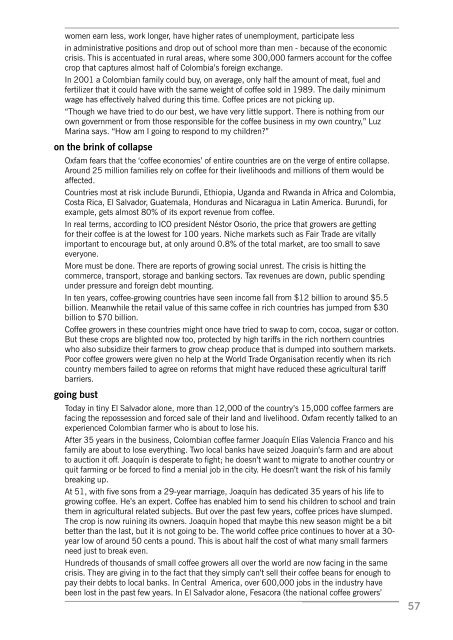Cost of coffee.indd - RISC
Cost of coffee.indd - RISC
Cost of coffee.indd - RISC
You also want an ePaper? Increase the reach of your titles
YUMPU automatically turns print PDFs into web optimized ePapers that Google loves.
women earn less, work longer, have higher rates <strong>of</strong> unemployment, participate less<br />
in administrative positions and drop out <strong>of</strong> school more than men - because <strong>of</strong> the economic<br />
crisis. This is accentuated in rural areas, where some 300,000 farmers account for the c<strong>of</strong>fee<br />
crop that captures almost half <strong>of</strong> Colombia’s foreign exchange.<br />
In 2001 a Colombian family could buy, on average, only half the amount <strong>of</strong> meat, fuel and<br />
fertilizer that it could have with the same weight <strong>of</strong> c<strong>of</strong>fee sold in 1989. The daily minimum<br />
wage has effectively halved during this time. C<strong>of</strong>fee prices are not picking up.<br />
“Though we have tried to do our best, we have very little support. There is nothing from our<br />
own government or from those responsible for the c<strong>of</strong>fee business in my own country,” Luz<br />
Marina says. “How am I going to respond to my children?”<br />
on the brink <strong>of</strong> collapse<br />
Oxfam fears that the ‘c<strong>of</strong>fee economies’ <strong>of</strong> entire countries are on the verge <strong>of</strong> entire collapse.<br />
Around 25 million families rely on c<strong>of</strong>fee for their livelihoods and millions <strong>of</strong> them would be<br />
affected.<br />
Countries most at risk include Burundi, Ethiopia, Uganda and Rwanda in Africa and Colombia,<br />
<strong>Cost</strong>a Rica, El Salvador, Guatemala, Honduras and Nicaragua in Latin America. Burundi, for<br />
example, gets almost 80% <strong>of</strong> its export revenue from c<strong>of</strong>fee.<br />
In real terms, according to ICO president Néstor Osorio, the price that growers are getting<br />
for their c<strong>of</strong>fee is at the lowest for 100 years. Niche markets such as Fair Trade are vitally<br />
important to encourage but, at only around 0.8% <strong>of</strong> the total market, are too small to save<br />
everyone.<br />
More must be done. There are reports <strong>of</strong> growing social unrest. The crisis is hitting the<br />
commerce, transport, storage and banking sectors. Tax revenues are down, public spending<br />
under pressure and foreign debt mounting.<br />
In ten years, c<strong>of</strong>fee-growing countries have seen income fall from $12 billion to around $5.5<br />
billion. Meanwhile the retail value <strong>of</strong> this same c<strong>of</strong>fee in rich countries has jumped from $30<br />
billion to $70 billion.<br />
C<strong>of</strong>fee growers in these countries might once have tried to swap to corn, cocoa, sugar or cotton.<br />
But these crops are blighted now too, protected by high tariffs in the rich northern countries<br />
who also subsidize their farmers to grow cheap produce that is dumped into southern markets.<br />
Poor c<strong>of</strong>fee growers were given no help at the World Trade Organisation recently when its rich<br />
country members failed to agree on reforms that might have reduced these agricultural tariff<br />
barriers.<br />
going bust<br />
Today in tiny El Salvador alone, more than 12,000 <strong>of</strong> the country’s 15,000 c<strong>of</strong>fee farmers are<br />
facing the repossession and forced sale <strong>of</strong> their land and livelihood. Oxfam recently talked to an<br />
experienced Colombian farmer who is about to lose his.<br />
After 35 years in the business, Colombian c<strong>of</strong>fee farmer Joaquín Elías Valencia Franco and his<br />
family are about to lose everything. Two local banks have seized Joaquin’s farm and are about<br />
to auction it <strong>of</strong>f. Joaquín is desperate to fight; he doesn’t want to migrate to another country or<br />
quit farming or be forced to find a menial job in the city. He doesn’t want the risk <strong>of</strong> his family<br />
breaking up.<br />
At 51, with five sons from a 29-year marriage, Joaquín has dedicated 35 years <strong>of</strong> his life to<br />
growing c<strong>of</strong>fee. He’s an expert. C<strong>of</strong>fee has enabled him to send his children to school and train<br />
them in agricultural related subjects. But over the past few years, c<strong>of</strong>fee prices have slumped.<br />
The crop is now ruining its owners. Joaquín hoped that maybe this new season might be a bit<br />
better than the last, but it is not going to be. The world c<strong>of</strong>fee price continues to hover at a 30-<br />
year low <strong>of</strong> around 50 cents a pound. This is about half the cost <strong>of</strong> what many small farmers<br />
need just to break even.<br />
Hundreds <strong>of</strong> thousands <strong>of</strong> small c<strong>of</strong>fee growers all over the world are now facing in the same<br />
crisis. They are giving in to the fact that they simply can’t sell their c<strong>of</strong>fee beans for enough to<br />
pay their debts to local banks. In Central America, over 600,000 jobs in the industry have<br />
been lost in the past few years. In El Salvador alone, Fesacora (the national c<strong>of</strong>fee growers’<br />
57




